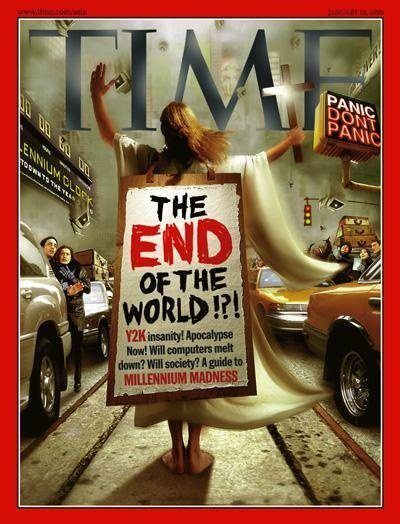

1999
Doomsday!

With 1999 came the end of the millennium and the predictions of doomsday. There was some debate about if the new millennium began on January 1st, 2000, or 2001. Technically, the Anno Domini system of counting years began with the year 1 (there was no year zero) and therefore the first millennium was from the year 1 to the end of the year 1000, the second millennium from 1001 to the end of 2000, and the third millennium beginning with 2001. Regardless of the fact that the millennium wasn’t officially over, people considered the new millennium to begin with the year 2000 and with it came prophesies of the collapse of society and Doomsday.
The collapse of society, people projected, was due to computers, or more specifically, the computer year 2000 problem, or just Y2K as it came to be known. Computers, which had only been around for the past fifty years, by the year 2000, had become crucial for running business throughout the world, particularly telecommunication and banking. In the early days of computers, computer memory was a scarce resource and thus computer programs were written to conserve memory and the recording of dates was one way to do so. Recording the date 1999 as just “99” saved two characters of storage, and in banking this was a considerable savings when there were thousands, or even hundreds of thousands, of transactions with dates that needed to be recorded. Why store the initial “19” for the year, after all everyone knew it was “19”, when you wrote checks you simply wrote the date as 12/22/99. So, programs were written to store only the last two digits of the year.
The storage of years for banks was just the tip of the proverbially iceberg, most all programs, including the operating systems of the computers used a two-digit year. People predicted, at the turn of the millennium at midnight on December 31st, 1999, to January 1st, 2000, computer systems would fail and lead to the collapse of the financial systems and other computer-based systems throughout the world and lead to the collapse of society.
The Y2K problem had been known and predicted for some time, the popular computer magazine Computerworld, which I regularly read, had an article in 1993 titled “Doomsday 2000". Of course, the year 2000 was seven years away, plenty of time to fix the computer programs before then. Yeah, right. Companies started getting more serious about it in ’98, and come 1999, with Y2K regularly in the news, companies started getting frantic about fixing the programs. Y2K computer programmers, those hired to specifically fix the problem, were in high demand, especially COBOL programmers as most business software were written in the COBOL computer language.
Even before 1 January 2000 arrived, there were also some worries about computer dates. The date September 9, 1999 (with two-digit date) would be recorded as “9999”. Data entry operators commonly entered 9999 into required fields for an unknown future date, (e.g., a termination date for cable television or telephone service), and on this date it was predicted services would be terminated.
I had been doing computer programming professional since the early 70’s and so was very much aware of the problem. Back in ‘88 I got laid off from Paravant partially due to a programming error in which the time change from midnight went to 1 PM instead of 12 AM, and the year was even stored as two digits, but it didn’t matter at the time. In my current job at PEC, we made sure all the operating systems and programs we were working on were Y2K updated.
As the end of the year approached businesses became rushed to make Y2K fixes to their systems, articles in papers and magazines were common. Christmas came and went. On New Year’s Eve I stayed up and watched New Year's celebrations around the world on TV starting first with Sidney in Australia and then progressing westward, Bombay, Israel, Paris, London. It became clear by 10:00 PM or so that there was not going to be any catastrophic computer failure, both a relief and a letdown.
Updated: 02-19-2024